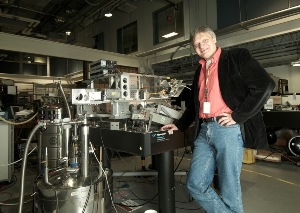Dec 21 2010
Using unique equipment developed by the National High Magnetic Field Laboratory at The Florida State University, an international team of researchers has used the spin of atomic nuclei in silicon to store information for longer than a minute and a half.
More remarkable still, the team showed that the information can be read out electronically — a key step toward the development of faster conventional computers and superfast “quantum” computers.
 Associate scholar/scientist Johan van Tol
Associate scholar/scientist Johan van Tol
The research was published Friday, Dec. 17, in the journal Science. Co-authors on the landmark paper are Johan van Tol, an associate scholar/scientist at the magnet lab; Gavin Morley of the London Centre for Nanotechnology; Dane McCamey of the University of Utah and University of Sydney; and Christoph Boehme of the University of Utah.
As demand for smaller and faster electronics increases, many scientists are focusing their efforts in the emerging field of “spintronics,” where the magnetic character, or spin, of electrons and nuclei are used to store information. While other researchers have shown that spin information can be processed in silicon, the material on which modern electronics and computing is based, until now, no effective way to both store and read out the information has been found.
“Finding a system compatible with silicon, the main material used in the semiconductor industry, is particularly useful as it has the potential to be incorporated into existing technology,” said McCamey, lead author of the Science paper. “We could then integrate spin-based information storage and processing devices onto a single chip.”
This is a new way of storing energy, said Boehme, a senior author on the paper.
“The length of spin memory we observed is more than adequate to create memories for computers,” he said.
Adequate, yes. But feasible? Not anytime soon, the authors caution. The nuclear spin storage-and-read-out apparatus works only at a few degrees Kelvin, or just slightly above absolute zero — the temperature at which even atoms almost stop moving. And it must be surrounded by high magnetic fields roughly 200,000 times stronger than Earth’s.
“Yes, you could immediately build a memory chip this way, but do you want a computer that has to be operated at 458 degrees below zero Fahrenheit and in a big national magnetic laboratory environment?” Boehme said. “First we want to learn how to do it at higher temperatures, which are more practical for a device, and without these strong magnetic fields to align the spins.”
The researchers used unique equipment for controlling electronic and nuclear spins in high magnetic fields and at very low temperatures to achieve their findings. The equipment was developed and built by van Tol and colleagues in the magnet lab’s Electron Magnetic Resonance user program.
“The high magnetic fields we use enable the electron spins to be lined up, initializing them so they are ready to store information,” van Tol said. “We now show that we can line up the nuclear spins too.”
“Electrical detection of electron spins is also the leading approach for detecting quantum information in silicon,” Morley added. “Future experiments could use this method to study quantum information stored in nuclear spins.”
The study was funded by the National High Magnetic Field Laboratory, the National Science Foundation, the Australian Research Council, Britain’s Engineering and Physical Sciences Research Council, and the Royal Commission for the Exhibition of 1851, a British funding agency led by Prince Philip.
The National High Magnetic Field Laboratory develops and operates state-of-the-art, high-magnetic-field facilities that faculty and visiting scientists and engineers use for research. The laboratory is sponsored by the National Science Foundation and the state of Florida.
Source: http://www.fsu.com/